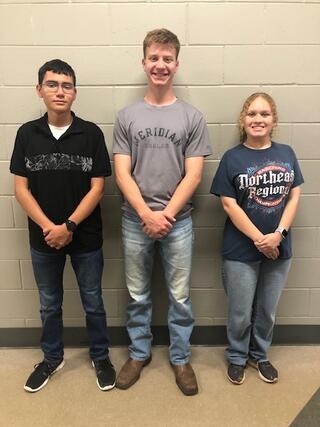
Neshoba Central Navy JROTC cadet Dakota Arnold will attend the National Flight Academy in Pensacola, Fla., later this month.
Three Neshoba Central High School Navy JROTC cadets will attend the National Flight Academy in Pensacola, Fla., later this month. What’s more, several cadets completed the FAA Part 107 Drone License curriculum. Three passed the test on Wednesday.
Since the Neshoba Central Navy JROTC program began in 2000, only one cadet, prior to these three, has been selected for the prestigious flight academy.
Upon graduation from the academy, cadets Dakota Arnold, Julian Perez and Curtis Benson will earn gold flight wings to wear on their JROTC uniforms.
“They will experience one of the most exciting and immersive learning adventures in the world aboard the world’s largest simulated aircraft carrier,” Capt. Regan Kieff, Neshoba’s Senior Naval Science Instructor and Unmanned Aircraft System Instructor, said.
“This will be an experience for rising 7-12th graders that inspires interest in Science, Technology, Engineering and Mathematics, commonly referred to as STEM.”
JROTC Instructor Chief Michael Bulloch said the three cadets received a full scholarship from the Mississippi Department of Education, valued at $1,500 each, to attend the flight academy.
“In order to fly a drone under the FAA’s Small UAS Rule (Part107), you must obtain a Remote Pilot Certificate from the FAA,” Capt. Kieff said.
“This certificate demonstrates that you understand the regulations, operating requirements and procedures for safely flying drones.”
The cadets who passed the test are now commercially licensed drone pilots and are ready to enter the workforce if they so choose.
“The drone curriculum is a really intensive program,” Kieff said. “It’s rigorous. It’s the ground/safety school before we start flying. Oftentimes kids think it is a toy. We’re teaching them to be commercially licensed pilots once they pass the test.”
This is the first year for Neshoba Central to offer the drone curriculum.
“It is very rigorous, especially for students who have zero aviation experience,” Kieff said.
Those who graduate will move on to the next part of the course, which is actually flying drones.
He said many companies with experienced drone pilots often hire a newly licensed pilot “to come in under their wings” and learn.
Others might require a minimum amount of flight time before a new pilot is considered, Kieff said.
Capt. Kieff said most people don’t realize that drones are connected to a number of jobs, pointing to the energy sector, agriculture and medical field, among others.
Drones are used to fly along high power lines looking for problems as well as by Realtors to fly properties.
“It’s huge in agriculture because they fly over crops a lot and survey for potential crop dusting,” Kieff said. “It’s really a big deal in the medical sector, too.”
Neshoba Central’s drone and other programs are embedded into others such as agriculture, digital media, JROTC and engineering. This coincides with the school district’s mission for all students to graduate both college and career ready with courses, certifications and external opportunities beyond a high school diploma.
 Story by Debbie Burt Myers
Story by Debbie Burt Myers
